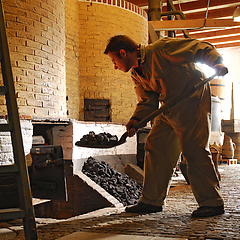Farmstead cheese is a raw-milk cheese that is made of the milk of cows, sheep and goats that are kept within a 3 mile radius from the cheese dairy. The fresh, unpasteurised milk is acidified and subsequently coagulated with rennet during around 25 to 40 minutes. This process imitates the first digestion stage in a calf’s stomach. The coagulated milk will become thick and is cut, leaving curds. These are drained with warm water, which makes them shrink and partly washes out the lactose (milk sugar). Because sugar is transformed into acid during ripening, the taste of the farmstead cheese will be a bit sweeter this way. The curds are put into vats and pressed. Finally the cheese is salted, coated and ripened. By ripening various flavours will develop, the well-known young, matured, aged and even over-aged cheese, ranging from 4 to 6 weeks old up to more than a year old. The flavour of farmstead cheese is special. Due to the use of raw milk there are regional differences, which can be tasted. The different rations of the animals, different breeds and seasonal differences can also be tasted in the cheese.



